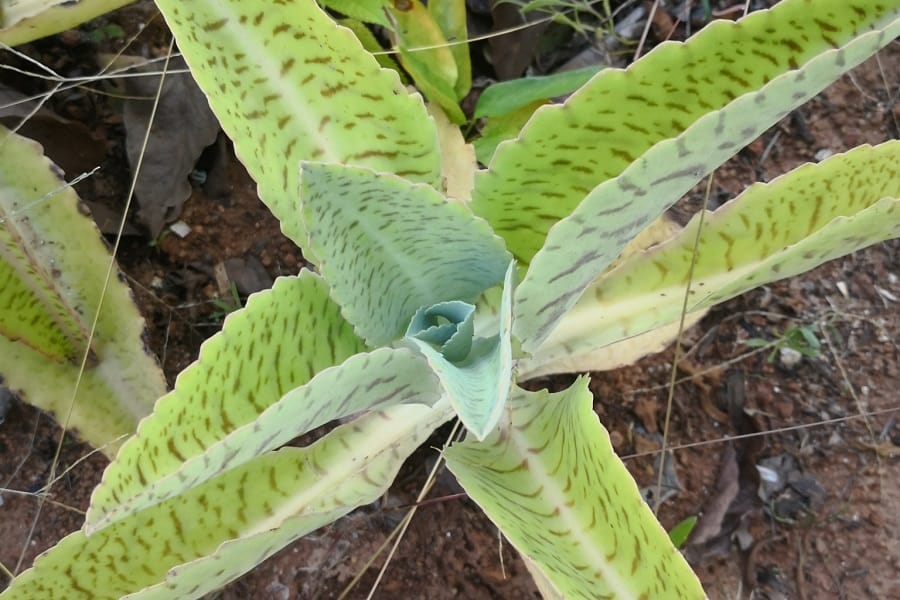Kalanchoe gastonis-bonnieri: Characteristics and Care
Have you ever seen a plant with fleshy leaves that look like donkey ears? Meet the Kalanchoe gastonis-bonnieri, also known as the “donkey ears” or “palm beachbells” plant! This unique succulent is sure to catch your eye with its thick, dark spotted leaves and vibrant red and yellow flowers topped with little plantlets.
While native to drier climates across the world, this hardy plant can thrive in your home or garden with just a little care. Let’s explore more about the donkey ears plant!

Related Post:
40+ Kalanchoe Lower Classifications With Pictures
Contents
Kalanchoe gastonis-bonnieri Medicinal Uses
Did you know the quirky donkey ears plant doesn’t just look cool – it also has amazing medicinal properties? For centuries, this succulent has been used in traditional medicine to treat all sorts of ailments.
In many African and Asian countries, the fleshy leaves are dried and ground into powders or pastes. These plant preparations are then used to make healing remedies for a variety of issues.
One common use is treating wounds, cuts, burns, and rashes. The juice from the donkey ears leaves contains compounds that can reduce inflammation, fight infection, and speed up healing when applied to injured skin.
The leaves also have pain-relieving and fever-reducing abilities when taken internally. Many people use donkey ears remedies to help with headaches, arthritis pain, stomach issues, and other inflammatory conditions
Caring for an Kalanchoe gastonis-bonnieri
The Right Light
Donkey ears love sunlight, but too much direct sun, especially in hot summer areas, can damage the plant. Place it in a lightly shaded spot outdoors or near a sunny window indoors. If growing with artificial light, use a quality grow light.
Water Wisdom
These drought-resistant plants don’t need frequent watering. Allow the soil to fully dry out between waterings, as too much moisture can lead to rotting roots and fungal issues. Underwatering will cause wilting leaves, so find the right balance.

The Perfect Soil
A fast-draining cactus or succulent soil mix is ideal, as donkey ears are prone to rot in soggy conditions. Make your own by mixing equal parts sand, peat moss, and clay for a loose, well-aerated blend.
No Fertilizer Needed
Donkey ears are low-maintenance when it comes to feeding. They can thrive without extra fertilizer, but you can use a slow-release fertilizer monthly or liquid fertilizer occasionally for extra lushness.
Temperature Tip
These sun-lovers prefer warm climates around 70-85°F and will bloom in summer. They can tolerate cool winter temps down to around 55°F, but protect them from freezing using frost cloth or by moving indoors.

Pest Patrol
Keep an eye out for common succulent pests like mealybugs and aphids. Wipe leaves with an insecticide or neem oil solution to control infestations.
Kalanchoe gastonis bonnieri Propagation
One of the best things about the Kalanchoe gastonis-bonnieri is how easily you can grow new plants from just a few cuttings. Propagating donkey ears is an easy and satisfying process that every plant lover should try:
- Using clean, sharp shears, snip off 3-4 healthy leaf or stem cuttings from the main plant.
- Allow the cuttings to dry out for 2-3 days until the cut ends form calluses over the wounds. This prevents rotting later on.
- Fill a container with well-draining cactus or succulent soil mix. Lay the calloused cuttings on top of the soil.
- Don’t water the cuttings directly. Instead, use a spray bottle to lightly mist them with water 5 times per day.
- Place the cuttings in a bright spot but avoid direct sun exposure which can dry them out too quickly.
- After 2-3 weeks, you should see little roots beginning to sprout from the cuttings!
- Once roots are 1-2 inches long, you can start giving the cuttings a deeper watering like an established plant.
- Allow the new plants to continue growing larger before transplanting them into their own pots.
With a little time and patience, your donkey ears cuttings will grow into full, lush plants to appreciate or share with friends! Propagating succulents is an easy way to multiply your plant collection.
